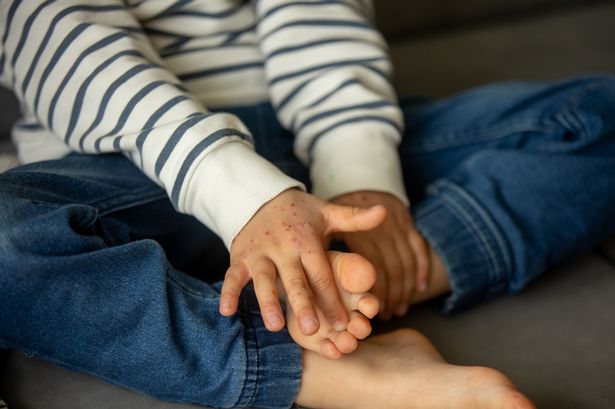Health
Health Experts Alert Parents as Schools Reopen to HFMD Risk

Parents, caregivers, and educators in Northern Ireland are urged to remain vigilant as children return to classrooms for the 2025/2026 academic year. Health experts are warning of an increased risk of hand, foot and mouth disease (HFMD), a common viral infection that primarily affects young children but can also impact adults. Although HFMD typically resolves on its own within 7 to 10 days, its contagious nature requires attention and preventative measures.
HFMD is not to be confused with foot and mouth disease, which affects livestock. The virus responsible for HFMD spreads through respiratory droplets in coughs and sneezes, as well as through contact with feces and fluid from blisters. According to the NHS, individuals can contract HFMD multiple times, and they may begin spreading the virus a few days before symptoms appear. The likelihood of transmission is highest during the first five days following the onset of symptoms.
Rising Concerns Over HFMD Symptoms
Searches for HFMD symptoms have surged significantly, with inquiries regarding the condition’s rash increasing by 411% in the past month. Dr. Pallavi Bradshaw, Deputy Chief Medical Officer at AXA Health, emphasized the importance of recognizing early symptoms to help mitigate the spread of this highly contagious infection. “With children returning to classrooms, it’s likely the UK will see a spike in common infections,” Dr. Bradshaw stated. “However, the surge in interest around HFMD suggests heightened concern among parents and caregivers.”
Dr. Bradshaw outlined the five key symptoms to watch for, which often progress in stages. Early recognition is critical to minimizing transmission. If a child begins to exhibit symptoms, it is vital to keep them at home for a minimum of five days until they feel better.
Preventative Measures Against HFMD
In addition to recognizing symptoms, health professionals recommend several precautions to limit the spread of HFMD within school communities. Dr. Bradshaw provided five essential tips:
1. Regular handwashing with soap and water, especially after using the toilet and before meals.
2. Disinfecting frequently touched surfaces and shared items.
3. Encouraging children to avoid close contact with infected individuals.
4. Teaching children to cover their mouths and noses when coughing or sneezing.
5. Keeping sick children at home until they have fully recovered.
Symptoms of HFMD are generally mild and resolve without medical intervention. However, if a child’s symptoms do not improve within ten days, parents are advised to seek guidance from their local healthcare provider.
As schools resume, the focus on health and safety remains paramount. By staying informed and proactive, parents and educators can help protect children and reduce the likelihood of HFMD outbreaks in schools.
-

 Health2 months ago
Health2 months agoNeurologist Warns Excessive Use of Supplements Can Harm Brain
-

 Health2 months ago
Health2 months agoFiona Phillips’ Husband Shares Heartfelt Update on Her Alzheimer’s Journey
-

 Science6 days ago
Science6 days agoBrian Cox Addresses Claims of Alien Probe in 3I/ATLAS Discovery
-

 Science4 days ago
Science4 days agoNASA Investigates Unusual Comet 3I/ATLAS; New Findings Emerge
-

 World2 months ago
World2 months agoCole Palmer’s Cryptic Message to Kobbie Mainoo Following Loan Talks
-

 Entertainment3 months ago
Entertainment3 months agoKerry Katona Discusses Future Baby Plans and Brian McFadden’s Wedding
-

 Entertainment3 months ago
Entertainment3 months agoEmmerdale Faces Tension as Dylan and April’s Lives Hang in the Balance
-

 Entertainment3 months ago
Entertainment3 months agoLove Island Star Toni Laite’s Mother Expresses Disappointment Over Coupling Decision
-

 Entertainment2 months ago
Entertainment2 months agoMajor Cast Changes at Coronation Street: Exits and Returns in 2025
-

 Science1 day ago
Science1 day agoScientists Examine 3I/ATLAS: Alien Artifact or Cosmic Oddity?
-

 World2 months ago
World2 months agoCoronation Street’s Asha Alahan Faces Heartbreaking Assault
-

 Entertainment2 weeks ago
Entertainment2 weeks agoStefan Dennis and Dianne Buswell Share Health Update on Strictly Come Dancing









